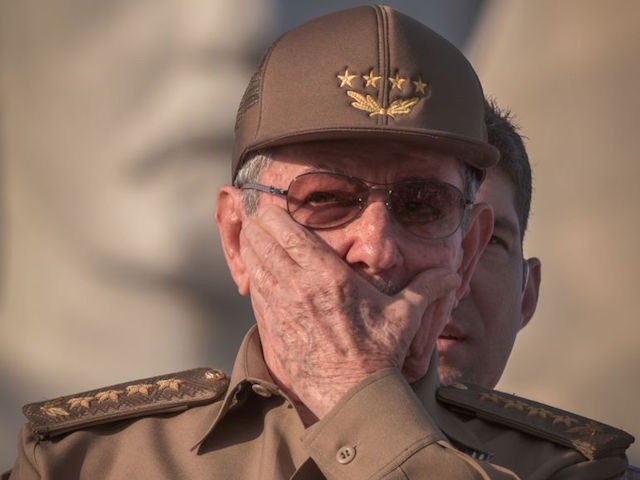The Communist Party of Cuba trotted out 90-year-old Raúl Castro – the nation’s ultimate leader despite his official retirement – on Monday, claiming he participated in a Politburo meeting on the protests hitting the island on Sunday.
Cubans in at least 20 localities around the island organized peaceful manifestations on Sunday believed to have attracted thousands of people. Many marched chanting “freedom!” and slogans in opposition to communism. The immediate response from the Communist Party was violence; Cubans have uploaded multiple videos to social media appearing to show police officers opening fire on crowds of protesters, beating them with batons on the streets, and arresting and disappearing participants in the protests. Manifestations continued throughout Monday but the regime shut down access to the internet nearly across the country, preventing Cubans from sharing breaking news from the island outside of encrypted messages and some isolated images.
The official Communist Party newspaper, Granma, and state television claimed that Castro participated in the meeting alongside President Miguel Díaz-Canel, who Castro hand-picked to be the face of the Party. Cuba experts consider Castro and his extended family the ultimate bosses in Cuba, however, as many hold high-ranking military and Party positions and Raúl Castro himself still resurfaces for events the Party deems important enough.
Granma did not describe the meeting as an “emergency” gathering but gave the impression that it was an urgent attempt to organize a response to the protests. The meeting reportedly occurred on Sunday, but was the lead story on Granma‘s online homepage on Tuesday morning.
“During the meeting, the provocations orchestrated by counterrevolutionary elements, organized and financed from the United States with destabilizing purposes, were analyzed,” Granma reported.
Granma offered no other information. It published no images that would prove that the nonagenarian dictator was present at the meeting. While its front-page headline promised video content, the video was a news report by communist media featuring only an anchor sitting at a desk and reporting that the meeting had occurred.
Prominently advertising Castro’s involvement in decisionmaking surrounding the protests appears to be a response to the outsized attention the protests have given Díaz-Canel. A longtime Communist Party lackey, Díaz-Canel first became president of the country in 2018. The Cuban constitution states that the president of the country is outranked by the Chairman of the Communist Party of Cuba and the commander-in-chief of the armed forces. Castro held all three titles before giving Díaz-Canel the presidency, remaining his boss. At the time, Díaz-Canel promised Castro would “preside over all major decisions for the present and future of the nation.”
Castro claimed to have retired in April 2021, giving Díaz-Canel the title of chairman of the Party. His public return indicates, however, that Díaz-Canel still lacks ultimate authority in the country.
Protests continued – and, reportedly, intensified – on Monday. The few images surfacing show severely injured unarmed protesters. One video appeared to show an unconscious man bleeding to death on the street while bystanders attempting to wrap the gunshot wound in his head with cloth to save him. Amnesty International has confirmed 115 arrests as of Tuesday, many of them of prominent members of the Cuban dissident community who have been subject to routine arbitrary detentions for decades.
Cubalex, an independent human rights group, documented over 150 people either missing or in police custody without being accused of a crime as of Tuesday and continues to update its database in real time.
The U.S.-based Martí News reported on Tuesday that the Communist Party had deployed motorized gangs to attack the protests – a staple repressive tactic of Cuba’s colony, Venezuela.
The violence followed a direct order from Díaz-Canel, issued in a televised speech, late on Sunday to “revolutionaries” to take the streets and attack peaceful protesters. Díaz-Canel called it an “order of combat” against “counterrevolutionaries” and explicitly urged violence.
On Monday, Díaz-Canel posted another call to violence on Twitter.
“The Cuban Revolution will not turn the other cheek to those who attack it, in both virtual and real-life spaces,” Díaz-Canel wrote, an apparent rebuke of Christian doctrine. The Communist Party is explicitly atheist and has regularly persecuted Christians of all denominations since 1959. The Castro regime actively persecuted Christians in the 1960s by placing them in the Military Units to Aid Production (UMAP), labor camps for “undesirables” and “counterrevolutionaries.” Several of those arrested and beaten on Sunday and Monday are members of Christian clergy.
“Let us avoid revolutionary violence but we will repress counterrevolutionary violence,” Díaz-Canel’s statement on Twitter continued. “Whoever attacks the agents of order attacks the country.”
Despite the call to “repression,” Díaz-Canel’s tweet remains available on that platform at press time.
La #RevoluciónCubana no va a poner la otra mejilla a quienes la atacan en espacios virtuales y reales. Evitaremos la violencia revolucionaria, pero reprimiremos la violencia contrarrevolucionaria. Quien ataca a los agentes del orden ataca al país #SomosCuba pic.twitter.com/7lLPk30wcV
— Miguel Díaz-Canel Bermúdez (@DiazCanelB) July 12, 2021
Granma reported on Monday that, following the Politburo meeting and call to violence, Díaz-Canel held a Party meeting on Monday to discuss several unrelated topics, apparently ignoring the protests. Among them was the failing Cuban power grid and its fully collapsed socialist healthcare system.
Follow Frances Martel on Facebook and Twitter.

COMMENTS
Please let us know if you're having issues with commenting.